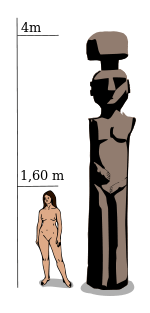Chemamull
Chemamüll ("wooden person", from Mapuche che "people" and mamüll "wood") are Mapuche statues made of wood used to signal the grave of a deceased person.[1][2]
Wooden statues or chemamüll
Description

Proportion of a chemamüll, Mapuche funeral statue, over a person.
The chemamüll are carved wooden statues, usually more than 2 metres (6 ft 7 in) tall, that represent the stylized body and head of a human being. Statues may have male or female features. The Mapuche used whole logs of either Nothofagus obliqua, a hardwood, or laurel for their chemamüll.
The Mapuche made chemamüll in pre-Columbian times in a manner similar to headstones. According to testimony in books, chemamüll helped the deceased's soul reunite with its ancestors. This sculpture stood by the deceased during the funeral and was then erected over the grave.
gollark: You could use any image and just add a ZIP with `__main__.py` in it on the end.
gollark: In this, yes.
gollark: This is just a ZIP concatted on the end, but if you muck with the formats a lot you could probably use some of the image data to store code.
gollark: So you can run this (`python3 logo96.png`) and it prints hello world, and as you can see it's a valid image.
gollark: <@!336962240848855040> So I don't know if any image format will let you stick a shebang at the start, *but* python apparently happily runs `__main__.py` from ZIP files. And ZIP files are backwards and work fine at the end of an image.
References
- "Chemamull". www.monumentos.gob.cl/. 2020. Retrieved 13 May 2020.
- Liencura, Jaime (26 February 2015). "¿Qué son los chemamüll? Las estatuas mapuches que recibió el Canciller Muñoz". Publimetro (in Spanish). Chile. Retrieved 13 May 2020.
External links
This article is issued from Wikipedia. The text is licensed under Creative Commons - Attribution - Sharealike. Additional terms may apply for the media files.
